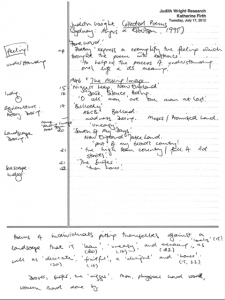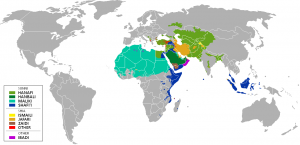
Useful, this is.
Turn your notes into writing using the Cornell method
This post is by Dr Katherine Firth who works in Academic Skills at the University of Melbourne, with a particular interest in research student literacies. Basically, Katherine is a Thesis Whisperer, like me. Unlike me, Katherine is still an active researcher in her field of 20th-century poetry. Over coffee Katherine told me about the ‘Cornell Method’ and kindly agreed to write a post. I found it enlightening, I hope you do too.
I take a lot of notes. Even when I was doing my PhD and I was taking thousands of pages of notes, I took them by hand. I tried using a computer, but there are so many things that are really hard to do on screen (drawing an arrow to make a connection between points, for example) that are really quick on paper. Also, you only need one hand to write notes, but two hands to type. And that free hand comes in useful for holding open books, grasping coffee cups, or stuffing your face with Gummi bears.
. . . . .

Firstly, the template gives you less space to write notes. You aren’t supposed to record everything you see, or even everything that is interesting. Having fewer lines to write notes encourages you to be selective—just to chose the quotes or paraphrases or details you expect to include in your thesis. It’s so liberating. And it’s so quick. In under an hour, I went from opening the book for the first time to producing the notes in Figure 2.
Secondly, the template gives you a bigger margin than in a usual ruled note book. This is where you put key words, identify themes, or recurrent patterns. This is great to helping you to analyse what you’re putting down, and to find the relevant quote when you go back to it. It also helps you to stay on track. You can check: ‘are my key words the same as the ones in my research question / thesis title?’
But thirdly, and most valuably, the template gives you a big space at the bottom to write sentences that summarise the page. That is, you start writing your critical response on the notes themselves.
Continue reading “Yoda: Cornell Notes Method & Online Template”






